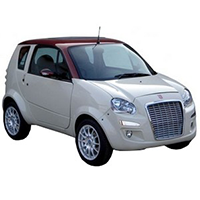
Catalog / Grecav
Grecav: Pioneering Mobility Solutions with Italian Microcars
Grecav, an Italian microcar manufacturer, has carved out a unique niche in the automotive industry since its establishment in 1964. Founded by the Grecav family in Gonzaga, Italy, the company initially focused on producing agricultural machinery and components. However, it was their venture into the world of microcars that would define Grecav's identity in the automotive landscape.
The company's transition to microcar production began in the 1990s, responding to a growing demand for compact, fuel-efficient vehicles suitable for urban environments. This shift marked a significant turning point in Grecav's history, aligning the company with emerging trends in personal mobility and environmental consciousness.
Interesting fact: Grecav's microcars fall into the category of 'quadricycles' under European regulations. This classification allows them to be driven with a moped license in many countries, making them accessible to younger drivers or those who don't hold a full car driving license. This unique positioning has been a key factor in Grecav's appeal, especially in markets with strict licensing requirements.
Throughout its history, Grecav has maintained a focus on innovation within the microcar segment. The company has consistently worked on improving the safety, efficiency, and comfort of its vehicles, challenging the perception of what a microcar can offer. Grecav's commitment to quality and safety has been particularly noteworthy, as they strive to provide robust protection despite the vehicles' small size.
In the early 2000s, Grecav introduced one of its most recognizable models, the Sonique. This microcar showcased Grecav's ability to combine compact design with a touch of style, appealing to urban dwellers looking for a practical yet fashionable mode of transportation. The Sonique, along with other models like the Eke and Giotto, helped establish Grecav's reputation in the microcar market.
Grecav's approach to vehicle design has always been centered around practicality and efficiency. Their microcars are engineered to maximize interior space while maintaining a minimal footprint, making them ideal for navigating tight city streets and fitting into small parking spaces. This focus on urban utility has made Grecav vehicles popular in congested European cities where space is at a premium.
Environmental considerations have played an increasingly important role in Grecav's development strategy. As awareness of climate change and urban air quality has grown, Grecav has invested in developing more eco-friendly powertrains. While initially relying on small, efficient diesel engines, the company has been exploring electric and hybrid options to align with the broader automotive industry's shift towards electrification.
Despite facing competition from larger automotive manufacturers entering the microcar segment, Grecav has maintained its position through specialization and a deep understanding of its target market. The company's vehicles often appeal to niche segments, including elderly drivers, young urban professionals, and those looking for a second car for short trips.
As of 2024, Grecav continues to evolve its product line, adapting to changing regulations and consumer preferences. The company has been working on enhancing the technology offerings in its vehicles, incorporating modern infotainment systems and safety features to meet the expectations of contemporary buyers.
Grecav's journey from an agricultural machinery manufacturer to a specialized microcar producer reflects the dynamic nature of the automotive industry. By finding and serving a specific market need, Grecav has demonstrated the potential for small, focused companies to thrive alongside global automotive giants.
Looking to the future, Grecav faces both challenges and opportunities. The increasing focus on electric mobility presents a chance for the company to leverage its expertise in compact vehicle design to create innovative electric microcars. However, it also faces the challenge of adapting to rapidly changing technology and stringent emissions regulations.
Grecav's story is one of adaptation and specialization. In a world where personal mobility is constantly evolving, Grecav's commitment to providing efficient, accessible transportation solutions continues to make it a notable player in the European microcar market. As urban areas grapple with issues of congestion and environmental impact, Grecav's microcars offer a glimpse into one possible future of city transportation.


